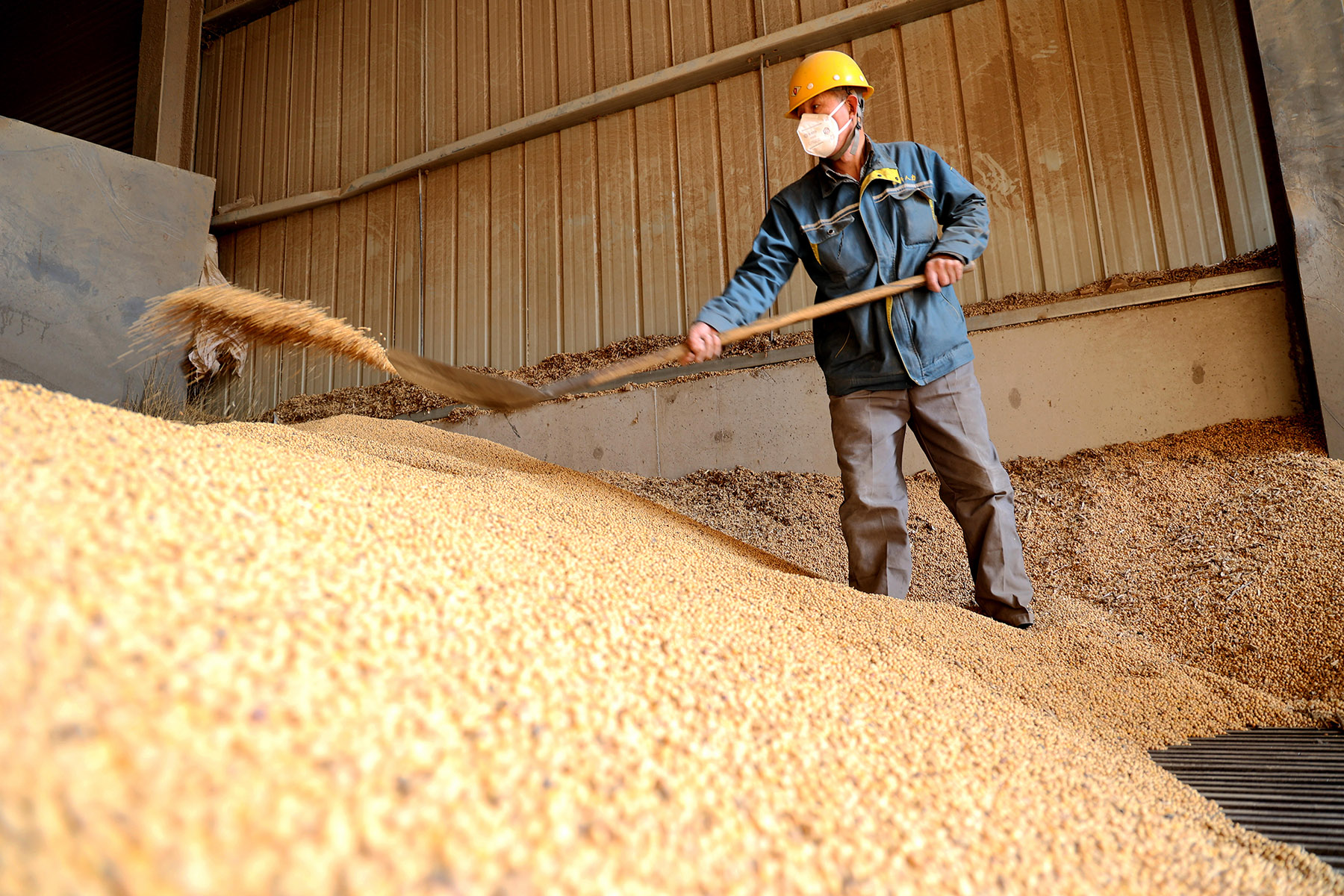Tariff impacts force growers to stockpile crops, wait for government aid

Unresolved trade negotiations and the United States' tariffs are having a devastating effect on US soybean farmers due to the absence of orders from China, the world's largest soybean importer, according to agricultural groups and experts.
"It's extremely unfortunate that soybeans are targeted as something to use as a pressure point in these high-level negotiations between China and the United States," said Jim Sutter, CEO of the US Soybean Export Council, who recently went on a trip to Asia, including China.
"This long relationship between Chinese importers and US exporters and farmers … we'd like to see that getting back to normal," he told China Daily.
Lia Nogueira, an associate professor in the Department of Agricultural Economics at the University of Nebraska-Lincoln, said China's role as a buyer of US soybeans before the trade disruptions was "very, very important".
READ MORE: China urges US to remove unreasonable tariffs for trade expansion
"US farmers are definitely feeling the effects of not having China as a market anymore," she said. China's shift to Brazil and Argentina has not only cut US farmers off from their largest market, but also pushed global soybean prices downward, creating a "double effect" of lost markets and lower prices for US producers, she added.
"Brazil and Argentina have been filling that gap at cheaper prices," Nogueira said.
Before Donald Trump launched his trade war against China in 2018 during his first term as US president, China purchased between one quarter and a third of all US soybean production. Since then, China has been trying to develop alternative sources.
In recent years, Brazil has significantly increased its exports to the Chinese market. Last year, 71 percent of China's soybean imports came from Brazil.
Argentina's recent policy changes have intensified competition. On Sept 22, Argentina announced the temporary elimination of export taxes on soybeans, once as high as 26 percent, and on soy oil and soy meal (24.5 percent) — stimulating $7 billion in sales within two days. These changes have further pressured US farmers.

Immediate impacts
The US Department of Agriculture projects a 117 million metric ton soybean harvest this year. But without China, which historically has accounted for 60 percent of US soybean exports, farmers in key agricultural states like Nebraska, Iowa and North Dakota are struggling with storage overflows and financial losses.
In Nebraska, cash prices are hovering below production costs, according to the Nebraska Farmers Union.
Reggie Strickland, a North Carolina soybean farmer, explained the immediate impacts on the harvest.
"We're putting it into storage now, and that relieves the pressure from the farmers' perspective. We're hoping that we can continue to build the relationship and get the markets opened into China, and then we'll be willing to sell when the price is at a point that we can afford to do so," Strickland told China Daily.
His experience reflects broader concerns. Farmers are planning storage strategies 45 days before they harvest, according to Carlos Salinas, executive director of East Asia for the USSEC. Salinas said the US has substantial storage capacity. Iowa, for example, can store three times its grain production.
However, the rise in unsold crops due to lost Chinese demand is overwhelming facilities, and storage limits are being tested.
In North Dakota, there were no orders for new crop soybeans, according to the American Soybean Association, which cited BNSF Railway and regional exporters in its Aug 19 letter to Trump. In mid-September, North Dakota soybeans that would normally be harvested and exported to Asia were piling up in large steel bins, The New York Times reported.
Farmers in the state face $240 to $360 losses per hectare, said association chairman Josh Gackle, with his own farm potentially losing over $400,000.
The trade disruption originates from US tariffs, including a 145 percent threatened level directed at China earlier this year, which prompted Beijing's 20 percent retaliatory tariff on US soybeans.
Reshaping global market
With total duties reaching 34 percent, including value-added taxes, US soybeans are being priced out of the market, according to a Farmdoc Daily report released by the University of Illinois.
US soybean exports to China fell to zero in June and July, the first time since 2004, according to US Census Bureau data. Through July, US exports declined by 51.3 percent, equivalent to a $2.6 billion loss. Overall agricultural exports to China dropped 53 percent in the first seven months of 2025 compared with 2024, USDA data showed.
Nogueira said China's shift to South American suppliers had reshaped global markets.
"China has been buying a lot more from Brazil and Argentina, and just the way the commodities have been moved around has affected world prices," she said, adding that this creates a "double effect" for US farmers, who lose both their primary market and face depressed global prices.
On Sept 23, Li Chenggang, China international trade representative with the Ministry of Commerce and vice minister of commerce, met a delegation of political and business leaders from the US Midwest. Despite the headwinds in China-US trade, the two sides exchanged views on topics including bilateral economic and trade relations and cooperation at the sub-national level.
After the meeting, Commerce Ministry spokesperson He Yadong said in a statement, "Regarding the trade of soybeans, the United States should take positive action to cancel the relevant unreasonable tariffs to create conditions for expanding bilateral trade."
Cory Walters, an associate professor in the Department of Agricultural Economics at the University of Nebraska-Lincoln who grew up on a Montana farm that produces wheat, canola, barley and peas, told China Daily that during this harvest, farms' profitability "sucks" and may be "negative".
"A lot of farmers typically like to sell soybeans at harvest; they don't like storing them. Now they're forced into selling them at a much lower price than anticipated." Walters said farmers want to point out this is due to the tariffs.
He noted that a strong US dollar exacerbates the issue, as currency exchange rates make US soybeans less competitive, though this is overshadowed by the focus on tariffs and China's pivot to South America.

Fears for future
"We're in the middle of the worst economic downturn that I've seen in my 50 years," John Hansen, president of the Nebraska Farmers Union, said at a regional meeting in Beatrice, Nebraska, in September.
Don Schuller, a corn and soybean farmer, told ABC News: "Agriculture is our foundation here in Nebraska, and many states in the Midwest. If agriculture is failing here everything is going to fail."
Nogueira, the associate professor, stressed that the massive US soybean production cannot be consumed domestically, making international trade critical. "If we want to keep production at the volume that we have right now, or even increase it, we have to sell it in other countries," she said.
The ongoing US federal government shutdown, which started on Oct 1, has exacerbated the issues, experts said. USDA payments through its "Lapse of Funding Plan" have been delayed after all farm-loan activity by the Farm Service Agency was halted.
The Trump administration had reportedly planned to release a first round of aid to farmers, potentially drawing on billions of dollars from the USDA's internal accounts, according to major media reports.
However, a key fund that previously provided $28 billion in aid now only has $4 billion left, far below Republican estimates of $35 billion to $50 billion.
Disbursement of the aid also faces numerous obstacles. With the USDA largely closed due to the government shutdown, delivery of aid is hampered while any attempt to secure additional funding is likely to spark a fierce political battle in the US Congress.
Republican Senator Chuck Grassley from Iowa said billions of dollars in federal assistance could be provided to struggling farmers in two tranches. However, the bulk of any aid would require congressional approval before it can be distributed.
Grassley told reporters on Oct 8 the Trump administration could provide $4 billion from the coffers of the Commodity Credit Corp, an independent agency used to pay for agricultural programs. But he added colleagues on the Senate Agriculture Committee had told him appropriating additional aid for farmers would need Congress to act.
"All we hear from the administration is the need for $10 (billion) to $14 billion, so the final figure hasn't even been agreed upon," he said.
Walters, however, told China Daily that farmers preferred market access over government bailouts.
"The farmers will welcome it and perhaps say 'this is not a long-run solution. We need market access. We need our market access back that we have built up over the years'," he said.
"They don't want to rely on government money," Walters said, adding that market access is paramount.
He suggested that even a small purchase from China could jolt the market and signal a willingness to buy. "Maybe that will shock the market so much that the futures prices would go up."
ALSO READ: US small farmers devastated by tariff battles, shrinking markets
The USSEC's Salinas said a recent delegation to Beijing and Shanghai was warmly received by customers and stakeholders.
"We received a very good reception from the industry (and they said) that they would like to receive soybeans from the United States," Salinas said.
Christopher Wolf, a professor of agricultural economics at Cornell University, told the BBC, "China is just so big that when they buy things, it matters — and when they don't, it matters."
Salinas said he remained positive about the future of the US-China soybean trade relationship. He said China's Argentina deal for 5 million tons has limitations. "We understand China is looking for alternatives," he said.
Sutter was optimistic about the trade relationship. "Chinese buyers have always valued the consistent quality and reliability of US soybeans, which makes our product competitive when trade barriers are resolved," he said.
Belinda Robinson in New York contributed to this story.
Contact the writers at yifanxu@chinadailyusa.com


